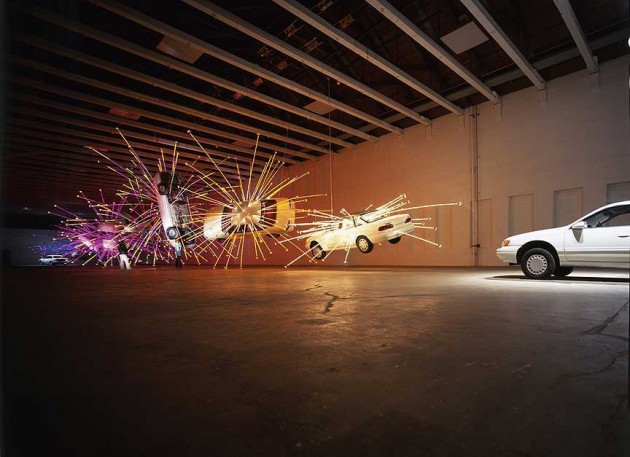Wednesday, November 18th, 2015
Cai Guo-Qiang’s “Inopportune: Stage One”
Last Friday, when I heard about the terrorist attacks in Paris, I couldn’t help but think of Cai Guo-Qiang’s Inopportune: Stage One (2004) which is on display in the Seattle Art Museum. Guo-Qiang first created this installation in 2004 for the Mass MoCA (it also was displayed at the Guggenheim in 2008). Nine Ford Taurus cars are laid out in a sequence, but the overall effect is to give the suggestion of one car that is flipping through the air (although time is standing still, so the viewer sees “freeze frame” shots of the car suspended). The first and the ninth car are placed on the ground, suggesting the beginning and end of motion, as well as the beginning and ending of an event: the exploding of a car bomb.

Cai Guo-Qiang, “Inopportune: Stage One” (2004). View of 2004 installation at Building 5 of MASS MoCA
Lights emanate from most of the cars, but the colors change as the cars flip through the air. The first few cars have lights from all different colors, which have been compared to fireworks.1 (As a Chinese artist, perhaps Guo-Qiang is connecting to his heritage by alluding to Chinese fireworks.) However, the last few cars (numbers seven and eight in the sequence) emanate different colors: blue, indigo, and purple. (I actually prefer the Mass MoCA installation setup for this reason, because you can best see how the colors of the lights change.) These colors suggest that the impact and heat of the bomb are dying out, as the explosion ends.
Guo-Qiang is a New Yorker, and he was deeply impacted by the terrorist attacks September 11, 2001. Inopportune: Stage One is a reference to 9-11 and also a reference to the world as it exists today (as the result of the events of 9-11).2 So, when I heard about the attacks in Paris, I couldn’t help but think of how this installation embodies the turmoil and upset that is still taking place because of terrorism. I also feel like this installation also can embody an element of hope and perspective too, since the cars and lights are suspended and presented in a beautiful and lyrical way:
“We live in a world full of terror, of discussion and fear of terror. However, if you present only that, you are not providing a perspective. What if it is also something that is very beautiful and dreamlike? Does that reflect something? I always come back to this point: that art ought not to just restate what we know and how we live, it must provide a perspective, a distance.”3 – Cai Guo-Qiang
Ironically, I received notification just this afternoon that Inopportune: Stage One is going to be taken down from its permanent installation in the Brotman Forum at the Seattle Art Museum, starting soon after the beginning of the new year (January 2016). I’m torn about this decision, especially since I feel like the sentiment behind this installation, both in referencing terror and spreading beauty, is more poignant and needed than ever.
This evening, though, I wondered if maybe the visuals of this installation need to be altered to fit with today’s situation. I heard a segment on the radio saying that in years to come, we may look back and say that “The War on Terrorism 1” began in 2001 with an American initiative, and that “The War on Terrorism 2” began right now, in 2015, with the European response. Sadly, time will tell if this is the case. But this makes me wonder if a new installation of Inopportune would be appropriate, with perhaps Renault or Citroën cars suspended in the air.
1 Seattle Art Museum, “Inopportune: Stage One.” Accessed November 18, 2015. http://www1.seattleartmuseum.org/eMuseum/code/emuseum.asp?style=single¤trecord=1&page=search&profile=objects&searchdesc=Number%20is%202006.1&searchstring=Number/,/is/,/2006.1/,/0/,/0
2 Ibid.

What an interesting post! I have a very limited knowledge of Cai Guo-Qiang’s art, but I’ve gotten to know it a little better while teaching Asian and Contemporary Art History classes the last couple of semesters. The connection you brought up on fireworks is such a fascinating one with him and his heritage, and most of the works from him that I have come across relate to his use of gunpowder and fireworks.
Here’s a video that I’ve been showing my classes lately:
https://www.youtube.com/watch?v=ViVEUa9bn8w
It’s fun to see his process of using the gunpowder to leave impressions on the canvas. Also, until I saw this video, I didn’t realize that he was involved in the opening ceremonies of the Olympics in 2008.